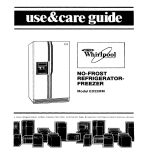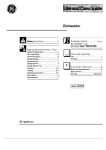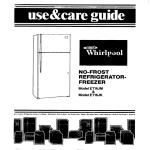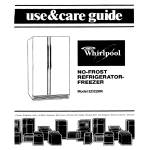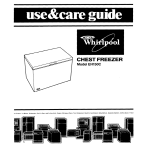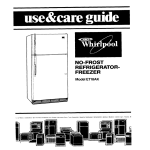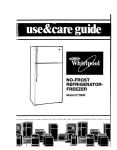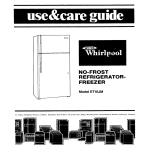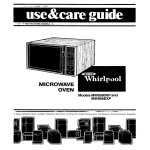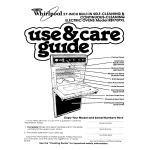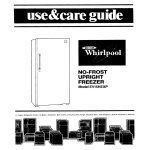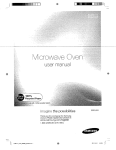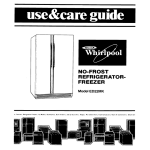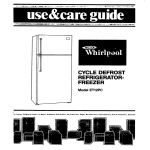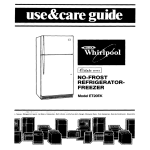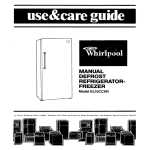Download Whirlpool ET18AK User's Manual
Transcript
NO-FROST O REFRIGERATORFREEZER MODEL ETl8AK IS. Freezers. Refrlgeralor-Freezers, Ice Makers, Dishwashers, Built-In Ovens and Surface Un~ls. Ranges, MIcrorave Ovens, Trash Compactors, Room Air Condllloners, Dehumldlflel Please read this Use and Care Guide before you do anything else.. . This booklet tells you how to start your refrigerator, clean it, move shelves and adjust controls. It even tells you what new sounds to expect from your refrigerator. Treat your new refrigerator with care. Use it only to do what home refrigerators are designed to do. Parts and features Control Light w Utility Compartment II Butter Compartment Power Saving Control Adjustable Shelves Model and Serial Number Copy your Model and Serial Numbers here.. . When you need service gr call with a question, have this Information ready: Model Number 1. Complete Model and Serial Numbers plate located as shown). Serial Number [from the 2. Purchase date from sales slip Purchase Date Copy this information in these spaces. Keep this book, your warranty and sales slip together In a handy place. 2 Service Company and Telephone Number Contents Page Ice Cube Trays Optional Automatic Ice Maker Sounds You May Hear Energy Saving Tips CLEANING YOUR REFRIGERATOR. Cleaning Chart FOOD STORAGE CHART. Storing Fresh Food Freezing and Storing Frozen Foods VACATION AND MOVING CARE, IF YOU NEED SERVICE OR ASSISTANCE 1, Before Calling for Assistance 2. If You Need Assistance 3. If You Need Service 4. IfYouHaveaProblem ,.,,.....,,,,, SAFETY FIRST BEFOREYOUPLUGITIN.~~~~~~~. Install Properly, Level Refrigerator-Freezer Remove Soles Labels Clean It Plugltln USINGYOUR REFRIGERATOR. Setting the Controls Changing the Control Settings Power Saving Control Changing the Light Bulb Moving the Meat Pan and Cover Adjusting the Refrigerator Shelves Removing the Crispers and Cover Removing and Adjusting the Freezer Shelf 7 7 8 8 8 9 10 10 11 14 15 15 15 15 15 7 01985 Whirlpool Corporation Before you plug it in IMPORTANT Before using your refrigerator, you ore personally responsible for making sure that it l is Installed and leveled on a floor that will hold the weight, and In on area surtable for its size and use. l is connected only to the rrght kind of outlet, with the right electrrcal supply and grounding (Refer to your “Electrical Requirements and Groundrng Instructions.“) l IS used only for jobs expected of home rem frigerators. l l l l l l IS not near on oven, radiator or other heat source. is properly maintained. IS out of the weather is used in on area where the room temperature will not fall below 55” F (13” C). is not used by those who may not understand how it should be used is not loaded with food before It has time to get properly cold Install properly.. Remove sales labels.. . . . IIII ml Remove the Consumer Buy Guide label, tape and any inside labels before using the refrigerator. To remove any remaining glue: I, Rub briskly with thumb to make a ball then remove. OR 2. Soak area with dishwashing detergent solutron (1 teaspoon detergent in 1 quart warm water] before removing glue as described in step 1. DO NOT USE rubbing alcohol or flammable or toxic solvents, such as acetone, gasoline, carbon tetrachloride, etc. These can damage the material. NOTE: DO NOT REMOVE ANY PERMANENT INSTRUCTION LABELS INSIDE YOUR REFRIGERATOR. Do not remove the Tech Sheet fastened under the refrigerator at the front. Clean it.. . Clean your refrigerator before usrng It. See cleanrng instructions onpageB.- ---t 1 Allow 3 inches (7.5 cm] between overhead cablnets and refrrgerator top. 2. Allow at least an inch (2 5 cm] between the refrigerator condenser on the back and the wall. 3 Allow 1/2 inch (1.25 cm] on each side of the refrigerator for ease of installation 4 If the refrigerator is to be against a wall, you might want to leave extra space on the hinge side so the door can be opened wider. Level refrigerator-freezer.. Leveling screw Plug it in... j-prong grounding type wall receptacle . Rc!lse 1 t Refrigerator Power Cord RECOMMENDED GROUNDING METHOD Lower Use Screwdriver to Adjust Right to Raise; Left to Lower 1. To raise front, turn each screw to the right 2 To lower front, turn each screw to the left 3. Check wrth level A 115 Volt, 60 Hz., AC only 15 or 20 ampere fused and properly grounded electrical supply is required. It is recommended that a separate circuit serving only this appliance be provided. Do not use an extension cord. Use a receptacle which cannot be turned oft with a switch or pull chain. See individual electrical requirements and grounding instruction sheet in your literature package. Using your refrigerator Refrigerator Control Setting the controls.. / Power Saving Control the control Glve the refrigerator pletely before adding eral hours.] These settings should household refrigerator settings.. be about usage. right for normal . If you need to adjust temperatures in refrigerator or freezer, use the settings listed in the chart below. l l l CONDITION: If Refrigerator Section is TOO WARM If Freezer Section is TOO WARM Adjust the Refrtgerator Control first. Wait at least 24 hours between adjustments Then adjust the Freezer Control, if needed. REASONS: Door opened often Large amount of food added Room temperature tco warm Door opened often Large amount of food added Very cold rcom temperature (can’t cycle often enough) Controls not set correctly for your conditions QUESTIONS? . ..call your If Refrigerator COOL-LINE 9 Section is service TOO COLD assistance If ICE isn’t telephone MADE FAST ENOl JGH number Wge 15). If BOTH SECTIONS are TOO WARM Power Saving Control.. time to cool down comfood. (This may toke sev- The controls will be set about right when milk or juice IS as cold as you like and when Ice cream IS firm. Set the FREEZER CONTROL to B. Changing Freezer Control . Controls for the refrrgerator and freezer are in the refrrgerator. When the refrigerator is plugged In for the first time PFFPICT~A.TT)I I, Set the REFRIGERA- TOR CONTROL to 3. 2 Light Switch Heavy ice usage Very cold room temperature (can’t cycle often enough] Door opened often Large amount of food added Very warm OTvery cold room temperatures RECOMMENDED SETTINGS: Refrigerator Freezer CONTROL 4 C Refrigerator Freezer Refrigerator Freezer Refrigerator Freezer Refrigerator Freezer . The Power Saving Control on the Control Console operates electric heaters around the door openings. These heaters help keep moisture from fcrmrng on the outside of the refrigerator. I. Use the CdNSUMES humrdity IS low. LESS ENERGY” setting when 2 Use the “REDUCES EXTERIOR MOISTURE” setting only If moisture forms on the outside of the refrigerator. 5 Changing the light bulb.. . Unplug the refrigerator first. 1. Reach behind control console to find bulb. 2. Remove bulb 3 Replace with a 40-w& appliance bulb. Moving the meat pan and cover... Glass is heavy. Be Careful. Frame support Frame Adjusting the refrigerator Shelves can be adjusted your refrigerator. Removing the Meat Pan: I, Slide the meat pan out to stop. 2. Lift the front. 3. Slide pan the rest of the way out. 4. Replace in reverse order Removing the cover: 1. Push up glass insert from bottom, then slide out with both hands. 2. Lift cover frame out of frame support 3. Tilt front of frame support up, lift at back, and pull support straight out. 4. Replace in reverse order. shelves... to match the way you use \ To remove shelves: 1. Tilt up at front. 2. Lift up at back. 3. Pull shelf straight out To replace: 1. Guide the rear hooks into the slots in the shelf supports. 2. Tilt up front of shelf until hooks drop into slot. Lower front of shelf to level position. Removing crispers and crisper cover. . . Removing the Crispers: 1. Slide crisper straight out to stop, lift front, then slrde the rest of the way out. 2 Replace in the reverse order Removing Cover: I. Push up glass insert from bottom, then sltde out with both hands. 2. Lift front of cover frame and remove cover support 3 Lift out cover frame by pulling up and out. Replacing Cover: 1 Frt back of cover into notch supports on walls of Remove the refrigerator, then lower front into place. Glass Insert. Lift the Frame Front, 2 Replace cover support with the long tab towards the front Note: If the support needs then the Back. adjustment, turn base rrght to lower, or left to raise. Glass is heavy. 3. Slide back of glass insert Into place, then lower front. Be Careful. Pull Out to Stop. Lift the Front 6 Removing and adjusting the freezer shelf... To remove shelf: 1. Lift front slightly 2 Loftback off supports. 3 Replace in reverse order To adjust shelf: 1 Remove shelf 2 Remove supports by slrding upwards 3 Replace supports on desired level. 4 Replace shelf Support Ice cube trays.. . To remove ice: 1 Hold tray at both ends. 2 Slrghtly twist If cubes are not used, they may shrink The moving cold arr starts a slow evaporatron The longer cubes are stored, the smaller they get Optional automatic ice maker.. . If you have the automatic ice maker accessory or plan to add one later [Port No. ECKMF-83). there are a few things you will want to know: l The ON/OFF lever is a wire signal arm. Down...for making ice automatically, Up...toshut off the ice maker. l Shake the bin occasionally to keep cubes sepa rated, and to obtarn increased storage capacity On l l l l l l l Lower Signal Arm to Start It. \ Raise Signal Arm to Stop Ice Maker. l It IS normal for ice crescents to be attached by a corner. They will break apart easily. You will hear water runnrng when Ice maker is working. You’ll hear ice fall into the bin Don’t let these sounds bother you. The Ice maker WIII not operate until the freezer is cold enough to make ice. This can take overnight. Because of new plumbing connections. the first ice may be discolored or off-flavored Drscard the first few batches of ice. If ice is not being made fast enough and more ice is needed, turn the Refrigerator Control toward a higher number. Wait a day and, If necessary. turn the Freezer Control toward A. If You remove the ice bin, raise the signal arm to shut off the Ice moker. When you return the bin. push It all the way in and lower the arm to the ON posItron. If cubes are stored too long, they may develop an off-flavor...like stale water. Throw them away. They will be replaced. Cubes In the ice bin can also become smaller by evaporation. The ice maker water supply should not be softened water. The chemicals could damage the ice maker molds, Sounds you may hear... ‘5 );, 3 ’ ,F Possible Sounds: Slight Hum, Soft Hiss: l Clicking Sounds: l or Snapping Water Sounds: l Ice Maker Sounds: -trickling water -thud (clatter of ice) l Running l Sounds: Your new refrigerator may make sounds that your old one didn’t. Because the sounds are new to you. you might be concerned about them. Don’t be. Most of the new sounds are normal. Hard surfaces like the floor. walls and cabinets can make the sounds seem louder. The following chart describes the kinds of sounds that might be new to you, and what may be making them. Probable Causes: You may hear the refrigerator’s fan motor and moving air The defrost timer makes a definite click when the refrigerator also makes a sound when the refrigerator starts. stops running. It When the refrigerator stops running, you may hear gurgling in the tubing for a few minutes after it stops. You may also hear defrost water running into the defrost water pan. If Your refrigerator has an Ice maker, you may hear buzzing (from the water valve), trickling water and the clatter of ice dumped into the bin Your refrigerator has a high-efficiency compressor and motor. It will run longer than older designs. It may even seem to run most of the time. Energy saving tips... You can help your refrigerator use less electricity. Check door gaskets for a tight seal Level the cabinet to be sure of a good seal l Clean the condenser coil regularly. l Open the door as few times as possible Think about what you need before you open the door. Get everything out at one time. Keep foods organized so you won’t have to search for what you want Close door as soon as food is removed. l Go ahead and fill up the refrigerator, but don’t overcrowd it so air movement IS blocked. l l l l It is a waste of electrtcrty to set the refrigerator and freezer to temperatures colder than they need to be. If Ice cream IS firm in the freezer and drinks are as cold as your family likes them, that’s cold enough. Keep the Power Saving Control on CONSUMES LESS ENERGY unless moisture forms on refrigerator exterior Make sure your refrigerator IS not next to a heat source such as a range, water heater, furnace, radiator, or in direct sunlight. Cleaning your refrigerator Both the refrigerator and freezer sections defrost automatically. But both should be cleaned about once a month to help prevent odors from building up. Of course, spills should be wiped up right away. To clean your refrigerator, turn the Refrigerator Control to OFF, unplug it, take out all removable parts, and clean it according to the followrng directions. Cleaning chart... Part What to use Removable parts [shelves, crisper, meat pan etc.) Mild detergent warm water. Outside Sponge, cloth or paper towel, mild detergent; appliance wax (or good auto paste wax] How to clean and Wash removable parts with warm water and a mild detergent. Rinse and dry l l Wash with warm water and a mrld detergent Do not use abrasive or harsh cleansers. Rinse and dry Wax painted metal surfaces at least twice a year with appliance wax or a good auto paste wax. Apply wax with a clean, soft cloth. Do not use wax on plastic parts. l l l Waxing Inside walls (Freezer should be allowed to warm up so cloth won’t stick.) painted metal Sponge, soft cloth or paper towel, bakrng soda, warm water, mild detergent. surfaces Sponge, soft cloth or paper towel; mild detergent, warm water DO NOT USE Cleaning bleaches or cleansers Dark plastics [covers and panels) Mild detergent and warm water; soft, clean sponge and soft, clean cloth. rust protection. Wash with warm water and ~ mild detergent or ~ baking soda (2 tablespoons 1 quart [ 95 I ] warm water Rinse and dry l l Door liners and gaskets provides l l Wash with mrld detergent water Rinse and dry and warm waxes, concentrated detergents, containing petroleum on plastic l l [ 26 g] to parts. Wash with a sof grit-free cloth or sponge Rinse and dry with a damp grit-free cloth or chamois DO NOT USE paper towels, window sprays, scouring cleansers, or flammable or toxic solvents like acetone, gasoline, carbon tetrachloride, etc. These can scratch or damage the material. Defrost pan [behind refrigerator on top of the motor) Warm water and mild detergerlt l l l l Condenser coils Use vacuum cleaner with brush attachment l l Floor under refrigerator Usual floor cleaners. l l l l Roll refrigerator out away from wall. Wash defrost pan with warm water and mild detergent. Do not remove defrost pan to clean. Rinse and dry Roll refrigerator back into place. Clean dust and lint from condenser coils behind the refrigerator at least once every other month. Leave an inch (2.54 cm] between wall and condenser coils on back of the refrigerator Roll refrigerator out away from wall. Wash floor. Roll refrrgerator back into place Check to see if the refrigerator IS level. Food storage guide STORING FRESH FOOD Cured or Smoked Meat and Cold Cuts. Ham, bacon, sausage, cold cuts, etc , keep best in orrgtnal wrappings. Once opened, tightly re-wrap in plastic wrap or aluminum foil. Canned Ham. State in refrigerator unless the label says it’s okay to store on the shelf. Do not freeze. Fresh Poultry. .Wrap In waxed paper or plastlc wrap The plastic wrap on poultry, as purchased may be used for storage STORAGECHART FOR FRESHAR0 CUREDMEAT* Fvpe There IS a right way to package and store refrigerated or frozen foods To keep foods fresher, longer, take the time to study these recommended steps. Leafy Vegetables Remove store wrapping and trim or tear off bruised arld &colored areas Wash in cold water and drain Fiace in plastic bag or plastic container and store in crisper. Cold, moist air helps keep leafy vegetables fresh and crisp Vegetables with Skins (carrots, peppers) .Store In crisper, plastic bags or plastic container. Fruits Wash, let dry and store in refrigerator in plastic bags or crisper. Do not wash or hull berries until they are ready to use. Sort and keep berries In their store container in a crrsper, or store In a loosely closed paper bag on a refrigerator shelf Meat is perishable and expensrve...you Meat= won’t want to waste an ounce of it through careless handling. The following list and chart give you packaging hunts and time limits. Store meat in the meat pan. Fresh, Prepackaged Meat. Store fresh meat in the store wrapping. Vacuum packaged meat can be frozen for as long as one month If the seal is not broken If you want to keep it frozen longer, you should wrap it wrth special freezer wrapping materrol. Fresh Meat, Not Prepackaged. Remove the market wrapping paper and re-wrap loosely In waxed paper or aluminum foil for storrng it unfrozen. Cooked Meat. Wrap or cover cooked meat with waxed paper, plastic wrap or aluminum forl. Store immediately. -ZZidenme Variety Meats . . . . . . . . . . . . . . . . . . . . 1 to2 Chlcken . . . . . . . . . . . . . . . . . . . . . . . . . . 1 to2 Ground Beef . . . . . . . . . . . . . . . . . . :. . . 1 to 2 SteaksandRoastr . . . . . . . . . . . . . . . . 3 to5 CuredMeats . . . . . . . . . . . . . . . . . . . . . 7tolO Bacon . . . . . . . . . . . . . . . . . . . . . . . . . . . . 5 to 7 Cold Cuts . . . . . . . . . . . . . . . . . . . . . . . . 3 to5 *If meat is to be stored longer than the times given, follow the directlons for freezing. NOTE: Fresh fish and shellfish should be used the same day as purchased Eggs .Store wrthout washing In the original carton or use the Utility Bin that came with your refrigerator MilkkWlpe milk cartons. For best storage, place mrlk on interior shelf Beverages.. Wipe bottles and cans. Store on a door shelf or inside the refrigerator. Butter.. Keep opened butter in covered dish or in the Butter Compartment. When storing an extra supply, wrap in freezer packaging and freeze Cheese .Store in the original wrapping until you are ready to use it. Once opened, re-wrap tightly in plastic wrap or aluminum foil. Condiments .Store small jars and bottles (catsup, mustard, jelly, olives] on the door shelves where they are in easy reach. Leftovers Cover leftovers with plastic wrap or aluminum foil to keep focd from dryrng out and transferring food odors, Plastic containers with tight lids are fine, too. FRFF7lNG A STORING FROZEN 4 I 7 6 3 The freezer section is designed for storage of cornmercrclly frozen foods and for freezing foods at home. Packaging -The secret of successful freezing is in the packaging. The wrap you use must be air, moisture and vapor proof. The way you close and seal the package must not allow air, moisture orvapor in or out. Packaging done in any other way could cause food odor and taste transfer throughout the refrigerator and drying of frozen food. Rigrd polyethylene [plastic) contarners with tightfitting lids, straight-sided cannrng/freezrng jars, heavy-duty aluminum foil, plastic-coated paper and non-permeable plastic wraps (such as Saran) are recommended. Note: Heat-sealed boiling bags are easy to use and can be used by themselves or as carton Irners. Sealing - When sealing foods in bags squeeze out the air (liquids need headspace to allow for expansion.) Twist the top and turn It back. Fasten tie securely around the doubled-over tall. Put the label Inside transparent bags; use self-adhesive label on outside of opaque ones. Air-tight wrapping calls for “drugstore” wrap Cut the sheet about one-third longer than the distance around the food Bring the ends together and fold rn [toward the food) at least twice to seal out air. Crease ends close to food, press err from package. Fold tips over twrce. Finish package and tape closed NOTt Wrth unboned meats, pad sharp edges wrth extr wrap or use stockinette to protect the wrap fror punctures DO NOT USE: Bread wrappers l Non-polyethylene plastic containers l Containers without tight lids l Waxed paper l Waxed-coated freezer wrap l Thin, semi-permeable wrap None of these are totally moisture, air or vapor proof. The use of these wrappings could cause food odor and taste transfer and drying of frozen food. l Freezing Fruits-Select ripe, blemish-free frui Be sure they taste as good as they look Wash 2 3 quarts (liters) at a time and dram Fruit that stanI In water may lose food value and become, sogc Sort, peel, trim, pit and slrce as needed. Pack in rigid wide-mouthed containers or 0th recommended materrol. Leave head space to ( low liquids to expand durtng freezing Freezing Vegetables - Freeze only fresh highquality vegetables picked when barely mature. For best results, freeze no more than 2 to 3 hours after picking. Wash in cold water, sort and cut into appropriate sizes. Blanch or scald. Pack in recommended container and freeze Do not freeze lettuce, celery, carrot sticks. potatoes or fresh tomatoes. All will become limp or mushy. Tomatoes will collapse when thawed Freezing Cooked Food - Prepare cooked foods as you would for the table; shorten cooking time10 to15 minutes toallow for additional cooking during reheating. Omit seasonings and part of the liquid. Plan to odd them at reheating time Potatoes should also be added to soup and stew at heating time Add crumb and cheese toppings at heating time. Cool as rapidly as possible and freeze at once. Liquid or semi-liquid dishes may be frozen in recommended containers with head-space. Casseroles and other more solid foods may be frozen in the baking container. If you don’t want to leave your casserole dish in the freezer, line it with foil. Bake, cool, freeze, lift out the foil package, bag it and return to freezer Freezing Meats-The meat you thaw can only be as good as the meat you freeze. “Drugstore” wrap In meal-size packages. Flat cuts or patties should be wrapped individually or in layers separated by a double thickness of freezer wrap. Make sure store wrappings are moisture and VCIpor proof. If not, re-wrap meats with one of the wraps recommended under “Packaging”. Freezing Baked Goods - Wrap baked breads in recommended material. Thaw in wrapping. Unbaked yeast breads can be frozen after the first rising. Punch down, wrap and freeze. Bake cookies as usual. Cool and freeze on trays. then pack in recommended freezer bags or cartons. Unbaked cookies may be dropped, molded or rolled and frozen on cookie trays. Store in bag or carton; bake without thawing. Refrigerator-type cookies can be wrapped and frozen in roll form. Thaw only enough to slice when ready to bake. Fruit pies are best frozen unbaked. Bake without thawing. Bake pecan and similar pies before freezing...rich fillings do not freeze sold Cut steam vents In top crusts when ready to bake. Bturaqu the IMPORTANT: Do not expect your any large freezer to quick-freeze quantity of food. Put no more unfrozen food into the freezer than wlll freeze withln 24 hours. (No more than 2 to 3 pounds of fresh meat or 3 to 4 pounds of vegetables per cubic foot of freezer space.) leave enough space for air to circulate around packages. Be careful MAIN DISHES Stem; meat, pouttry andffshccws+w@ . ..‘i TVdlnriufs .. . . -.‘.: ,....-; DAilwplttmMm Buftur’~ . . . . .,. . . . . , . . . . . . . . hkcw&g* .............. -tit, to leave &g& 2to3mo@hs 9te~month8 dto9moqth) 2w9fnonths .r: . r’ enough room at the front so the door can close tightly. FOODSTORAGECHART storage times* will vary according to the quality of the food, the type of packaging or shufbut EGW wrap used (fnoisture qnd vapor-proof), and (mixed). . . . . . . . . . 9 to12 manths . . . . . . . . . . . . . . . . . 9fOj2,mo‘niths Er . . . . . . . . . . . . . . . , . . 9 totill.r?ranths (Add sugar or salt to yotks arWh’& tiixed _ BAKF& WQst bruQd8 Qnd foil& . i. .%.. ~hl&hs the storage temperature 0” F (-17.86). yhich should be Sur~tfm. HUITS Fruit Juice concenfratq . . :. . 12 months Commerclafty frozon t&it . . 12 months Cifrus fruit and)ulces. 4. . 4 to 6 months Cfhew . . . . . . . . . . . . . . . .i. 8 tot2 months VEGETABUS Com~ocgly frozen . . . . . . . 8 months .-......... 8 toti monfhs . . . . . . . . . . . . . -.* . . . . . 4wweks WtWu Bokod Br~ti-~N 8-0 colk . . . . . . . . . . . . . . . . . . . . . . . &months Unbaked breads.. . . . . . . . , . .:%f month Wok bruods . . . .‘. ... . . . . 2’to $ nmmH% Baoon . . . . . . . . . . . , . . . . ‘4waeksofkss i3Qrftudbuuf . . . . . . . . ..-....... Iwo@ks Gurudham . . . . . . . ..a.... tto2months (!SalNn;,Et shortens freezer lity .I..,.., F..i..‘.... 1 month tthoh.ut~@muf, lamb, wai 2 to 3 months 4ib.i. . . . .:... . . . . ..+.. 6t0f2 month8 ” Lat!Erbandveol ..I . . . . . 6fa9months SQFIC. . . . . . . . . . . . . . . . . . . 4 to 8 months $aura*,fIvsh .:. . . . . . . . . tto2months Stuakmand ahaps: .. But -.. . . . . . . . . . , . . ..-. 8mtol2 months lamb, veal, pork . . #‘.. . 3 to4 months FISH Cod, flounder, haddock Sole.. . . . . . . . . . . . . . . . . . . . . . 6 months 8tuofhh. salmon . . . . . . . . 2 to3 months Mackerel, perch . . . . . . . . 2 t&t3 months Sreaded ffsh [purchased) T, . 3 months Clams, oysters. cookedL., fish, crub, scallops . . . . 3 to4 months Alaskankingorab .I........ lOmonths Shrimp, uncooked . . . . . . . . . 12 months PWURY Whofa ehkkon or turkey . . . . 12 months Duck . . . . . . . . . . . . . . . . . . . . . . . . 6 months @Wets . . . . . . . . . . . . . . . . . . 2 to 3 months Ceokud pouHry w/gravy . . . 6 montfw 8Bces (no gravy) . . . . . . . . . . . . . 1 month If electricity goes off Call the power compony. Ask how long power will be off. I. If service is to be interrupted 24 hours or less, keep both doors closed. This will help frozen foods to stay frozen. 2. If service IS to be Interrupted longer than 24 hours: [a] Remove all frozen food and store in Q frozen food locker. Or... (b) Place 2 Ibs (0.9 kg] of dry ice in freezer for every cu, ft. of freezer space. This will keep frozen foods for 2 to 4 days. (c) If neither food locker storage nor dry ice is available, use or con perishable food at once. 3. A full freezer will stay cold longerthan a portly filled one. A freezer full of meat will stay cold longer than a freezer full of baked goods. If food contarns Ice crystals, it may be safely refrozen, although the quality and flavor may be affected. Use refrozen foods quickly, If the condition of the food is poor or you hove any suspicions, it is wtse to dispose of It. Vacation Short vacations. .. Moving. No need to shut off the refrigerator If you ~111be away for less than four weeks. Use up perishables; freeze other items. If your refrigerator IS equipped with an automatic ice maker, 1) turn it off, 2) shut off the water supply to the Ice maker, 3) empty the ice bin. Long vacations. .. Remove all the food If you are going for a month or more. If your refrigerator is equipped with an automatic ice maker, turn off the water supply to the ice maker at least a day ahead. When the last load of ice drops, turn off the ice maker. Unplug the refrigerator and clean It.. rinse well ar,d dry Tape rubber or wood blocks to both doors ...keeping them open far enough for air to get In. This will keep odor and mold from building up. Tape the blocks out of a child’s reach...do not allow children near the retrigerator when the doors are blocked open. To restart refngerator, 14 see “Using Your Refrigerator ” .. If your refrigerator is equipped with an automatic Ice maker, shut off the ice maker water supply a day ahead of time. Disconnect the water line. After the last supply of ice drops, lift the signal arm to turn off the ice maker. Remove all food. Pack frozen foods in dry Ice. Unplug the refrigerator and clean it thoroughly. Remove everything that comes out. Wrap all parts well and tape them together so they don’t shift and rattle. Screw in the levelling rollers; tape the doors shut; tape the electric cord to the cabinet. When you get to your new home, put everything back, and refer to page 4. Don’t forget to reconnect the water supply line if you have an icemaker. QUESTIONS? .call your COOL-LINE” service assistance telephone number (page 15). If you need service or assistance, we suggest you follow these four steps: I. Before calling for assistance.. . Performance problems often result from little things you can find and frx yourself without tools of any krnd If your refrigerator will not operate: Is the electric cord plugged in7 l Is a fuse blown or a crrcurt breaker trapped? l Is the Refrrgerator Control turned ON? l If there is a rattling or jingling noise, or other unfamiliar sounds: l Is something on top or behrnd the refrigerator making noise when the refrigerator IS runnrng’ l New features on your new refrigerator make new sounds You may be hearing air flowrng from the fans, timer clicks for the defrostrng cycle, defrost water draining into the defrost pan. If your ice maker will not operate: l Has the freezer had enough time to get cold? With a new refrigerator, this mrght take overnight. l Is the signal arm ON.. in the down posItion l Is the water valve turned on? Is water getting to the ice maker? If there is water in the defrost pan: l In hot, muggy weather, this IS normal The pan can even be half full. Make sure the refrigerator is level so the pan doesn’t overflow. If the light doesn’t work: l Check fuses and circuit breakers. Make sure it’s plugged in. If a bulb is burned out: l See instructions for changing light bulbs on page 6 Use appliance bulbs only If the motor seems to run too much: l Are the condenser coils free of dust and lint? l On hot days, or if the room is warm, the motor naturally runs longer l If the door has been opened a lot, or if a large amount of food has been put In, the motor will run longer to cool down the interior. Remember: Motor running time depends on different things, number of door openings. amount of food stored, temperature of the room, setting of the controls. And, your new refrigerator may be larger than your old one so it has more space to be cooled It also has a regular freezer instead of a frozen food compartment. All this means better refrrgeratron and may require more running time than your old one. 2. If you need assistance”‘... Call Whirlpool COOL-LINE” service assistance telephone number. Dial free from: Contlnental U.S. . . . . . . . . . . . . (800) 253-1301 Mfchigan . . . . . . . . . . . . . . . . . . . (800) 632-2243 Alaska & Hawaii . . . . . . . . . . . (800) 253-1121 and talk with one of our trained Consultants. The Consultant can instruct you In how to obtain satisfactory operatron from your appliance or, if service is necessary, recommend a qualrfred service company in your area. 3. If you need service*... Whirlpool has a nationwide network of franchised TECH-CARE m Service Companies TECH-CARE servrce technicrans are trained to fulfill the product warranty and provide after-warranty service, anywhere in the United States. To locate --- -I KHKAlit service In your area, call our COOL-LINE service assistance telephone number (see Step 2) or look in your telephone drrectory Yellow Pages under. ELECTRICAL MAJOR- APPLIANCES - HOUSEHOLDMAJOR - SERVICE 8 REPAIR APPLIANCESREPAIRING 8 PARTS OR WHIRLPOOL APPLIANCES FRANCHISED TECH-CARE SCRVICE WHIRLPOOL APPLIANCES FRANCHISED TECH~CARE SERVICE SE/I\‘/1 ‘E ro.1lf’-\.Yf.h’.~ XYZ SERVICE CO 123 Maole 999-9999 SEHI’I(‘E ~‘o.\ll’4.\lt.\ XYZ SERVICE CO 123 Maole 999.9999 OR WASHING MACHINES, DRYERS 8 IRONERS - SERVICING WHIRLPOOL APPLIANCES FRANCHISED TECH CARE SERVICE .I‘b~HI’I(‘E XYZ SERVICE CO 123 Maple CO.%f/!4 Vlh.\ 999~9999 4. If you have a problem”‘... Call our COOL-LINE service assistance telephone number [see Step 2) and talk with one of our Consultants, or if you prefer, write to, Mr. Robert F Gunts, Vice President Whirlpool Corporation Administrative Center 2000 US-33 North Benton Harbor, MI 49022 -If you must call or write, please provide model number, serial number, date of purchase, and a complete description of the problem. This information IS needed In order to better respond to your request for assistance. 0 FSP R FSP IS a reqlsiered trademark of ‘Whirlpool Corporai16n for quality ports Look for this symboi of aualltv wherwver YOU need a rer3acement wrt for your 6Jh1rlpool a&lance FSP replacement parts will fit right and work rIghi because they are made to the same exoctlng speclllcations used to build every new Whirlpool appllonce Whirlpol Home b /Appliances Making your world a little easier. Part No. 1104622 01985 Whirlpool Corporation Makers. Dishwashers. Bu~ll-In Ovens and Surface Printed in U.S.A, Units. Ranges, MIcrowave Ovens, Trash Compactors. Room Air Condltloners. Dehumidifiers, Automatic Washers, Clothes Drye
















